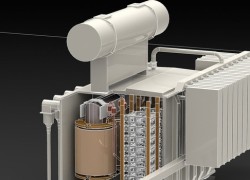
German conglomerate Siemens has launched a new direct-current technology solution, which enables cost-efficient and simplified grid connection for offshore wind power plants.
Unlike the conventionally used large central converter platforms, the new platform housing Siemens’ transmission technology will be much smaller and compact.
The firm is further developing the transmission technology, which can connect multiple smaller platforms sequentially in a wind farm and then route them to an onshore transformer substation.
The compact design of the new solution allows the use of encapsulated high-voltage electrical equipment, especially installation of diode rectifier units (DRUs), instead of the usual air-insulated transistor modules.
Each of the DRUs has a transmission capacity of 200MW, and is the core of the new transmission technology, along with the transformer, the smoothing reactor, and the rectifier, all of which are combined in one tank.
Besides being modular and flexible, the new solution reduces the volume of platform structures by four-fifths and weight by two-thirds, which, in turn, can result in cost reductions by more than 30%.
It also increases transmission capacity by one-third and reduces transmission losses by 20%.
Siemens Energy Management Division CEO Jan Mrosik said: “As the only provider on the market, we have already successfully commissioned four offshore direct-current connection projects. Now we are applying our experience directly to the next generation of direct-current grid connections.” He also said :
“Our new solution will play a major role in decreasing the cost of offshore wind power below ten cents per kilowatt hour by 2020. This is how we plan to make the direct-current technology used in Germany more interesting to other markets, too.”
German Federal Ministry of Economics and Energy (BMWi) is financing the new Siemens’ technology solution as a part of the federal government’s sixth energy research programme under the supervision of project sponsor Jülich.








